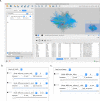Network propagation in the cytoscape cyberinfrastructure
- PMID: 29023449
- PMCID: PMC5638226
- DOI: 10.1371/journal.pcbi.1005598
Network propagation in the cytoscape cyberinfrastructure
Abstract
Network propagation is an important and widely used algorithm in systems biology, with applications in protein function prediction, disease gene prioritization, and patient stratification. However, up to this point it has required significant expertise to run. Here we extend the popular network analysis program Cytoscape to perform network propagation as an integrated function. Such integration greatly increases the access to network propagation by putting it in the hands of biologists and linking it to the many other types of network analysis and visualization available through Cytoscape. We demonstrate the power and utility of the algorithm by identifying mutations conferring resistance to Vemurafenib.
Conflict of interest statement
The authors have declared that no competing interests exist.
Figures


References
-
- Köhler S, Bauer S, Horn D, Robinson PN. Walking the interactome for prioritization of candidate disease genes. Am J Hum Genet. 2008;82: 949–958. doi: 10.1016/j.ajhg.2008.02.013 - DOI - PMC - PubMed
-
- Vanunu O, Magger O, Ruppin E, Shlomi T, Sharan R. Associating Genes and Protein Complexes with Disease via Network Propagation. PLoS Comput Biol. Public Library of Science; 2010;6: e1000641 doi: 10.1371/journal.pcbi.1000641 - DOI - PMC - PubMed
-
- Lee I, Blom UM, Wang PI, Shim JE, Marcotte EM. Prioritizing candidate disease genes by network-based boosting of genome-wide association data. Genome Res. 2011;21: 1109–1121. doi: 10.1101/gr.118992.110 - DOI - PMC - PubMed
-
- Vandin F, Upfal E, Raphael BJ. Algorithms for detecting significantly mutated pathways in cancer. J Comput Biol. 2011;18: 507–522. doi: 10.1089/cmb.2010.0265 - DOI - PubMed
MeSH terms
Substances
Grants and funding
LinkOut - more resources
Full Text Sources
Other Literature Sources

